Roper Logan Tierney Model Application: A Case Study of Kristy's Care
VerifiedAdded on 2023/06/12
|7
|2443
|381
Case Study
AI Summary
This case study applies the Roper Logan Tierney model to analyze the biological, psychological, cultural, and spiritual factors affecting a patient named Kristy following an accident. It examines the legal aspects of consent, the doctrine of necessity, and enduring guardianship in her situation. Preoperative nursing actions required for valid consent are discussed, along with the pathophysiology and pharmacological factors related to abnormal postoperative cues such as elevated heart rate, low body temperature, and high fasting blood sugar. The study also addresses the impact of these factors on Kristy's overall health and well-being, emphasizing the importance of postoperative assessment and monitoring to prevent potential complications. The document emphasizes the importance of holistic patient care and legal considerations in nursing practice.
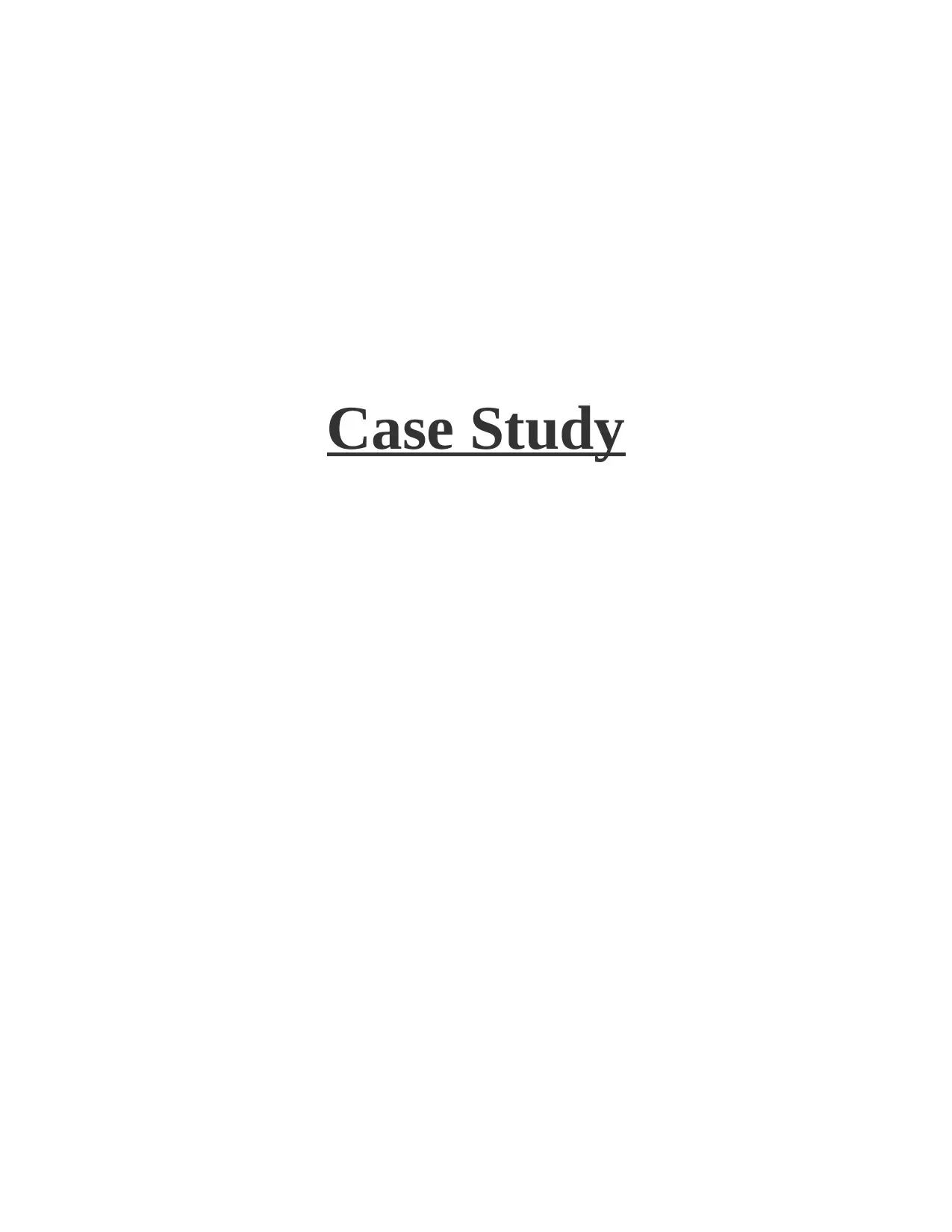
Case Study
Secure Best Marks with AI Grader
Need help grading? Try our AI Grader for instant feedback on your assignments.
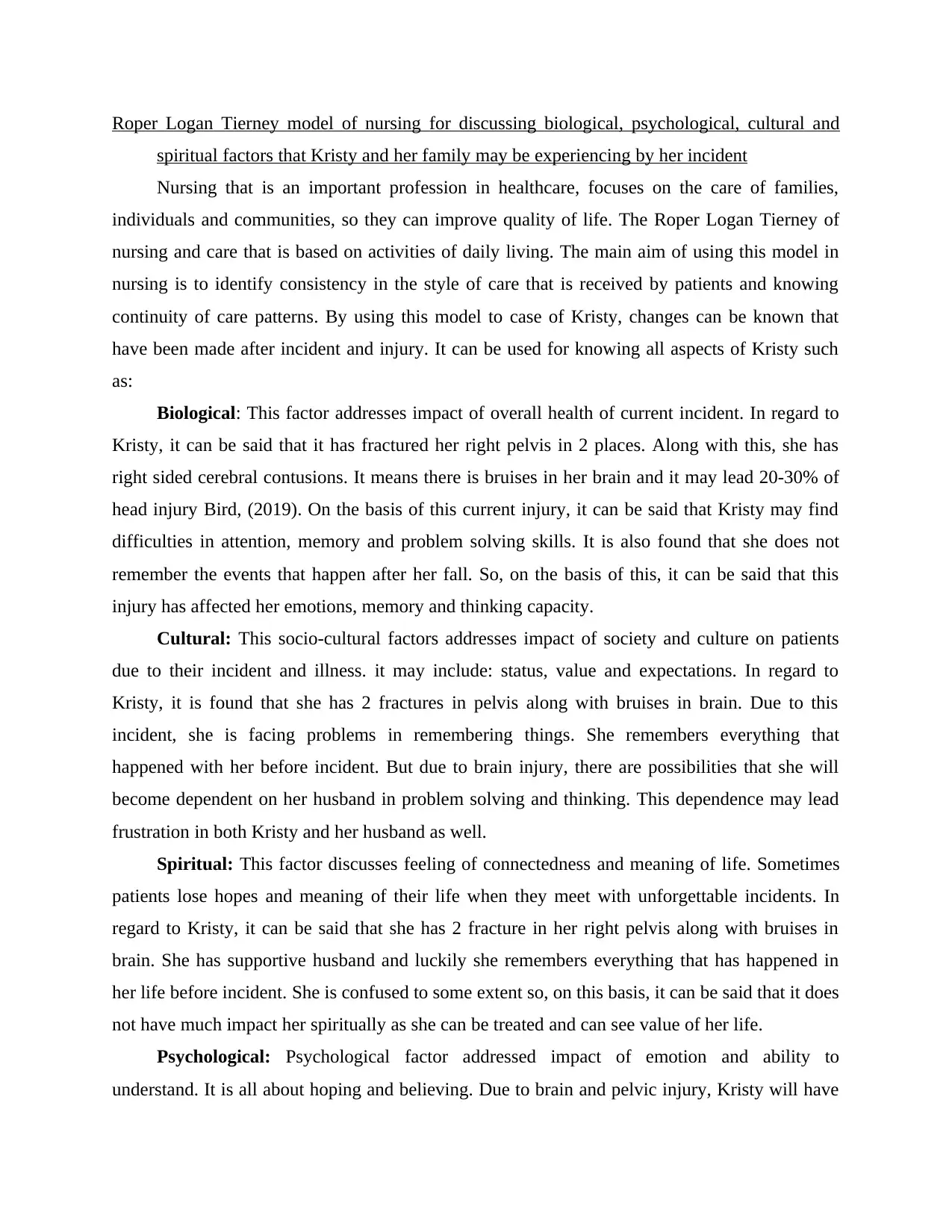
Roper Logan Tierney model of nursing for discussing biological, psychological, cultural and
spiritual factors that Kristy and her family may be experiencing by her incident
Nursing that is an important profession in healthcare, focuses on the care of families,
individuals and communities, so they can improve quality of life. The Roper Logan Tierney of
nursing and care that is based on activities of daily living. The main aim of using this model in
nursing is to identify consistency in the style of care that is received by patients and knowing
continuity of care patterns. By using this model to case of Kristy, changes can be known that
have been made after incident and injury. It can be used for knowing all aspects of Kristy such
as:
Biological: This factor addresses impact of overall health of current incident. In regard to
Kristy, it can be said that it has fractured her right pelvis in 2 places. Along with this, she has
right sided cerebral contusions. It means there is bruises in her brain and it may lead 20-30% of
head injury Bird, (2019). On the basis of this current injury, it can be said that Kristy may find
difficulties in attention, memory and problem solving skills. It is also found that she does not
remember the events that happen after her fall. So, on the basis of this, it can be said that this
injury has affected her emotions, memory and thinking capacity.
Cultural: This socio-cultural factors addresses impact of society and culture on patients
due to their incident and illness. it may include: status, value and expectations. In regard to
Kristy, it is found that she has 2 fractures in pelvis along with bruises in brain. Due to this
incident, she is facing problems in remembering things. She remembers everything that
happened with her before incident. But due to brain injury, there are possibilities that she will
become dependent on her husband in problem solving and thinking. This dependence may lead
frustration in both Kristy and her husband as well.
Spiritual: This factor discusses feeling of connectedness and meaning of life. Sometimes
patients lose hopes and meaning of their life when they meet with unforgettable incidents. In
regard to Kristy, it can be said that she has 2 fracture in her right pelvis along with bruises in
brain. She has supportive husband and luckily she remembers everything that has happened in
her life before incident. She is confused to some extent so, on this basis, it can be said that it does
not have much impact her spiritually as she can be treated and can see value of her life.
Psychological: Psychological factor addressed impact of emotion and ability to
understand. It is all about hoping and believing. Due to brain and pelvic injury, Kristy will have
spiritual factors that Kristy and her family may be experiencing by her incident
Nursing that is an important profession in healthcare, focuses on the care of families,
individuals and communities, so they can improve quality of life. The Roper Logan Tierney of
nursing and care that is based on activities of daily living. The main aim of using this model in
nursing is to identify consistency in the style of care that is received by patients and knowing
continuity of care patterns. By using this model to case of Kristy, changes can be known that
have been made after incident and injury. It can be used for knowing all aspects of Kristy such
as:
Biological: This factor addresses impact of overall health of current incident. In regard to
Kristy, it can be said that it has fractured her right pelvis in 2 places. Along with this, she has
right sided cerebral contusions. It means there is bruises in her brain and it may lead 20-30% of
head injury Bird, (2019). On the basis of this current injury, it can be said that Kristy may find
difficulties in attention, memory and problem solving skills. It is also found that she does not
remember the events that happen after her fall. So, on the basis of this, it can be said that this
injury has affected her emotions, memory and thinking capacity.
Cultural: This socio-cultural factors addresses impact of society and culture on patients
due to their incident and illness. it may include: status, value and expectations. In regard to
Kristy, it is found that she has 2 fractures in pelvis along with bruises in brain. Due to this
incident, she is facing problems in remembering things. She remembers everything that
happened with her before incident. But due to brain injury, there are possibilities that she will
become dependent on her husband in problem solving and thinking. This dependence may lead
frustration in both Kristy and her husband as well.
Spiritual: This factor discusses feeling of connectedness and meaning of life. Sometimes
patients lose hopes and meaning of their life when they meet with unforgettable incidents. In
regard to Kristy, it can be said that she has 2 fracture in her right pelvis along with bruises in
brain. She has supportive husband and luckily she remembers everything that has happened in
her life before incident. She is confused to some extent so, on this basis, it can be said that it does
not have much impact her spiritually as she can be treated and can see value of her life.
Psychological: Psychological factor addressed impact of emotion and ability to
understand. It is all about hoping and believing. Due to brain and pelvic injury, Kristy will have
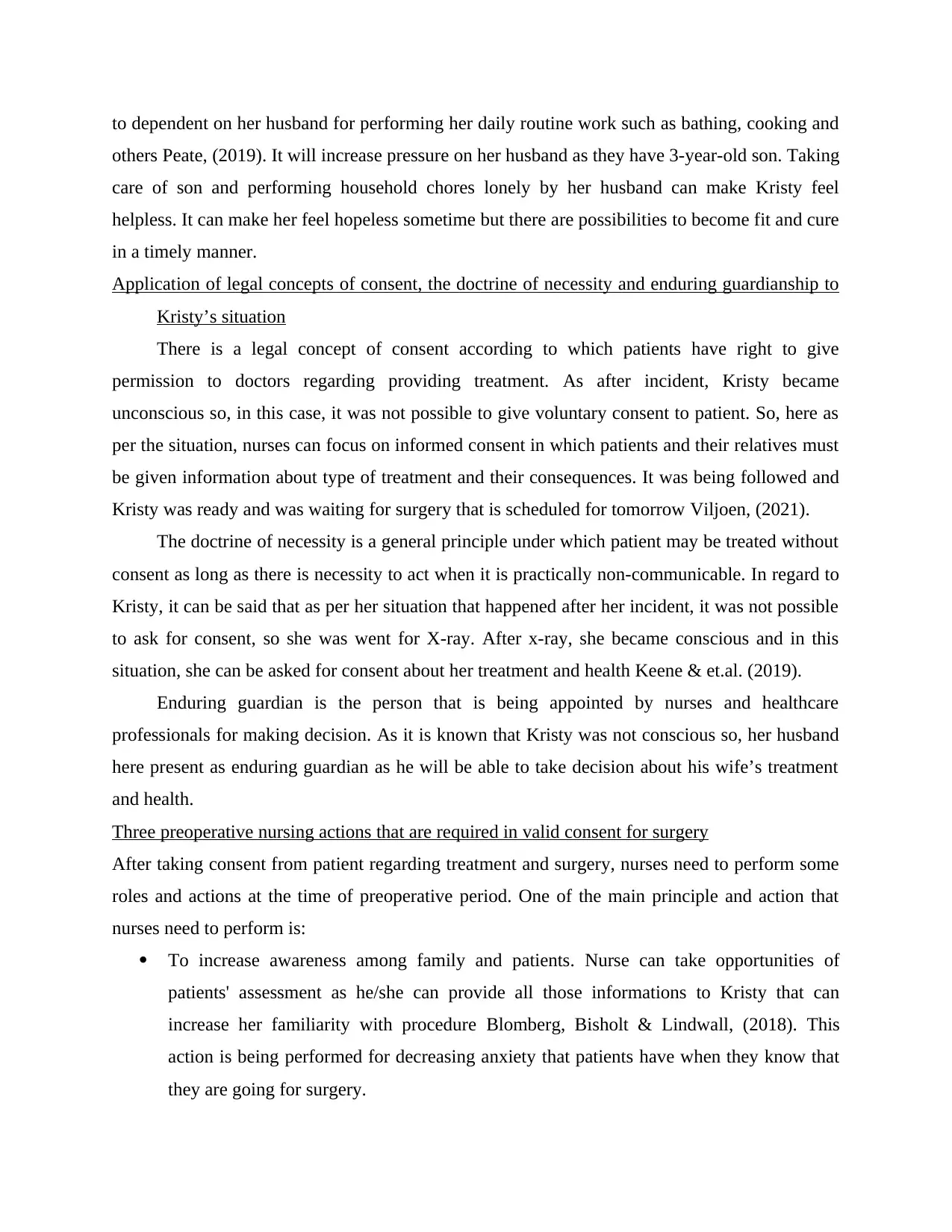
to dependent on her husband for performing her daily routine work such as bathing, cooking and
others Peate, (2019). It will increase pressure on her husband as they have 3-year-old son. Taking
care of son and performing household chores lonely by her husband can make Kristy feel
helpless. It can make her feel hopeless sometime but there are possibilities to become fit and cure
in a timely manner.
Application of legal concepts of consent, the doctrine of necessity and enduring guardianship to
Kristy’s situation
There is a legal concept of consent according to which patients have right to give
permission to doctors regarding providing treatment. As after incident, Kristy became
unconscious so, in this case, it was not possible to give voluntary consent to patient. So, here as
per the situation, nurses can focus on informed consent in which patients and their relatives must
be given information about type of treatment and their consequences. It was being followed and
Kristy was ready and was waiting for surgery that is scheduled for tomorrow Viljoen, (2021).
The doctrine of necessity is a general principle under which patient may be treated without
consent as long as there is necessity to act when it is practically non-communicable. In regard to
Kristy, it can be said that as per her situation that happened after her incident, it was not possible
to ask for consent, so she was went for X-ray. After x-ray, she became conscious and in this
situation, she can be asked for consent about her treatment and health Keene & et.al. (2019).
Enduring guardian is the person that is being appointed by nurses and healthcare
professionals for making decision. As it is known that Kristy was not conscious so, her husband
here present as enduring guardian as he will be able to take decision about his wife’s treatment
and health.
Three preoperative nursing actions that are required in valid consent for surgery
After taking consent from patient regarding treatment and surgery, nurses need to perform some
roles and actions at the time of preoperative period. One of the main principle and action that
nurses need to perform is:
To increase awareness among family and patients. Nurse can take opportunities of
patients' assessment as he/she can provide all those informations to Kristy that can
increase her familiarity with procedure Blomberg, Bisholt & Lindwall, (2018). This
action is being performed for decreasing anxiety that patients have when they know that
they are going for surgery.
others Peate, (2019). It will increase pressure on her husband as they have 3-year-old son. Taking
care of son and performing household chores lonely by her husband can make Kristy feel
helpless. It can make her feel hopeless sometime but there are possibilities to become fit and cure
in a timely manner.
Application of legal concepts of consent, the doctrine of necessity and enduring guardianship to
Kristy’s situation
There is a legal concept of consent according to which patients have right to give
permission to doctors regarding providing treatment. As after incident, Kristy became
unconscious so, in this case, it was not possible to give voluntary consent to patient. So, here as
per the situation, nurses can focus on informed consent in which patients and their relatives must
be given information about type of treatment and their consequences. It was being followed and
Kristy was ready and was waiting for surgery that is scheduled for tomorrow Viljoen, (2021).
The doctrine of necessity is a general principle under which patient may be treated without
consent as long as there is necessity to act when it is practically non-communicable. In regard to
Kristy, it can be said that as per her situation that happened after her incident, it was not possible
to ask for consent, so she was went for X-ray. After x-ray, she became conscious and in this
situation, she can be asked for consent about her treatment and health Keene & et.al. (2019).
Enduring guardian is the person that is being appointed by nurses and healthcare
professionals for making decision. As it is known that Kristy was not conscious so, her husband
here present as enduring guardian as he will be able to take decision about his wife’s treatment
and health.
Three preoperative nursing actions that are required in valid consent for surgery
After taking consent from patient regarding treatment and surgery, nurses need to perform some
roles and actions at the time of preoperative period. One of the main principle and action that
nurses need to perform is:
To increase awareness among family and patients. Nurse can take opportunities of
patients' assessment as he/she can provide all those informations to Kristy that can
increase her familiarity with procedure Blomberg, Bisholt & Lindwall, (2018). This
action is being performed for decreasing anxiety that patients have when they know that
they are going for surgery.

Teaching about post-operative pain control. Fear of pain is a common source of anxiety
that patients have and nurses can teach Kristy about better ways of post-operative pain
control.
Nurses need to ensure patient's safety that is universal protocol and joint commission
quality standard. As per this standard, nurses need to verify patient's identity, correct
surgical site and quality standard so that they can protect patients from wrong surgery
treatment and process. It happens many of the time when there are same names of
patients in the same ward so, for protecting wrong treatment, nurses often require
verifying patients' data. Along with this, in the case of Kristy where she is informed about
her surgery and has been taken consent, she should verbally confirm the surgical
procedure and accordingly, surgeon should mark the surgical site with the patient's
involvement Gröndahl & et.al. (2019). This pre-surgical verification needs to be
performed in the pre-operative area and then the time out is done in the OR immediately
or prior to surgery.
Pathophysiology and pharmacological factors related to Three abnormal cues in Kristy's post-
operative nursing assessment
Impact of current incident on overall health of Kristy as per the Roper Logan Tierney can be
known. It can be discussed with assessment, diagnosis, planning, intervention and evaluaton. In
regard to assessment, it can be said that Kristy was assessed with some normal symptoms and
vitals. Before discussing three abnormal cues in post-operative nursing assessment, it is
important to identify and discuss her normal assessment.
Blood pressure of Kristy is: 105/74 that is considered normal.
12-20 minutes’ breath rate is considered normal and RR of Kristy is 15bpm.
SP O2: 97%. Between 95-100 oxygen level is considered as normal
Some abnormal measurement of Kristy includes:
Heart rate of Kristy that was measured: 95bpm that is slightly high from normal
Normal human body temperature range is: 36.5-37.5-degree C but current body
temperature of Kristy is 35.8 that is not normal. In regard to this, it can be said that when
body temperature falls from 35 then it is considered as low body temperature and
hypothermia Liu & et.al. (2020). Patients with low body temperature require immediate
treatment as untreated can lead to brain damage as well as cardiac failure.
that patients have and nurses can teach Kristy about better ways of post-operative pain
control.
Nurses need to ensure patient's safety that is universal protocol and joint commission
quality standard. As per this standard, nurses need to verify patient's identity, correct
surgical site and quality standard so that they can protect patients from wrong surgery
treatment and process. It happens many of the time when there are same names of
patients in the same ward so, for protecting wrong treatment, nurses often require
verifying patients' data. Along with this, in the case of Kristy where she is informed about
her surgery and has been taken consent, she should verbally confirm the surgical
procedure and accordingly, surgeon should mark the surgical site with the patient's
involvement Gröndahl & et.al. (2019). This pre-surgical verification needs to be
performed in the pre-operative area and then the time out is done in the OR immediately
or prior to surgery.
Pathophysiology and pharmacological factors related to Three abnormal cues in Kristy's post-
operative nursing assessment
Impact of current incident on overall health of Kristy as per the Roper Logan Tierney can be
known. It can be discussed with assessment, diagnosis, planning, intervention and evaluaton. In
regard to assessment, it can be said that Kristy was assessed with some normal symptoms and
vitals. Before discussing three abnormal cues in post-operative nursing assessment, it is
important to identify and discuss her normal assessment.
Blood pressure of Kristy is: 105/74 that is considered normal.
12-20 minutes’ breath rate is considered normal and RR of Kristy is 15bpm.
SP O2: 97%. Between 95-100 oxygen level is considered as normal
Some abnormal measurement of Kristy includes:
Heart rate of Kristy that was measured: 95bpm that is slightly high from normal
Normal human body temperature range is: 36.5-37.5-degree C but current body
temperature of Kristy is 35.8 that is not normal. In regard to this, it can be said that when
body temperature falls from 35 then it is considered as low body temperature and
hypothermia Liu & et.al. (2020). Patients with low body temperature require immediate
treatment as untreated can lead to brain damage as well as cardiac failure.
Secure Best Marks with AI Grader
Need help grading? Try our AI Grader for instant feedback on your assignments.
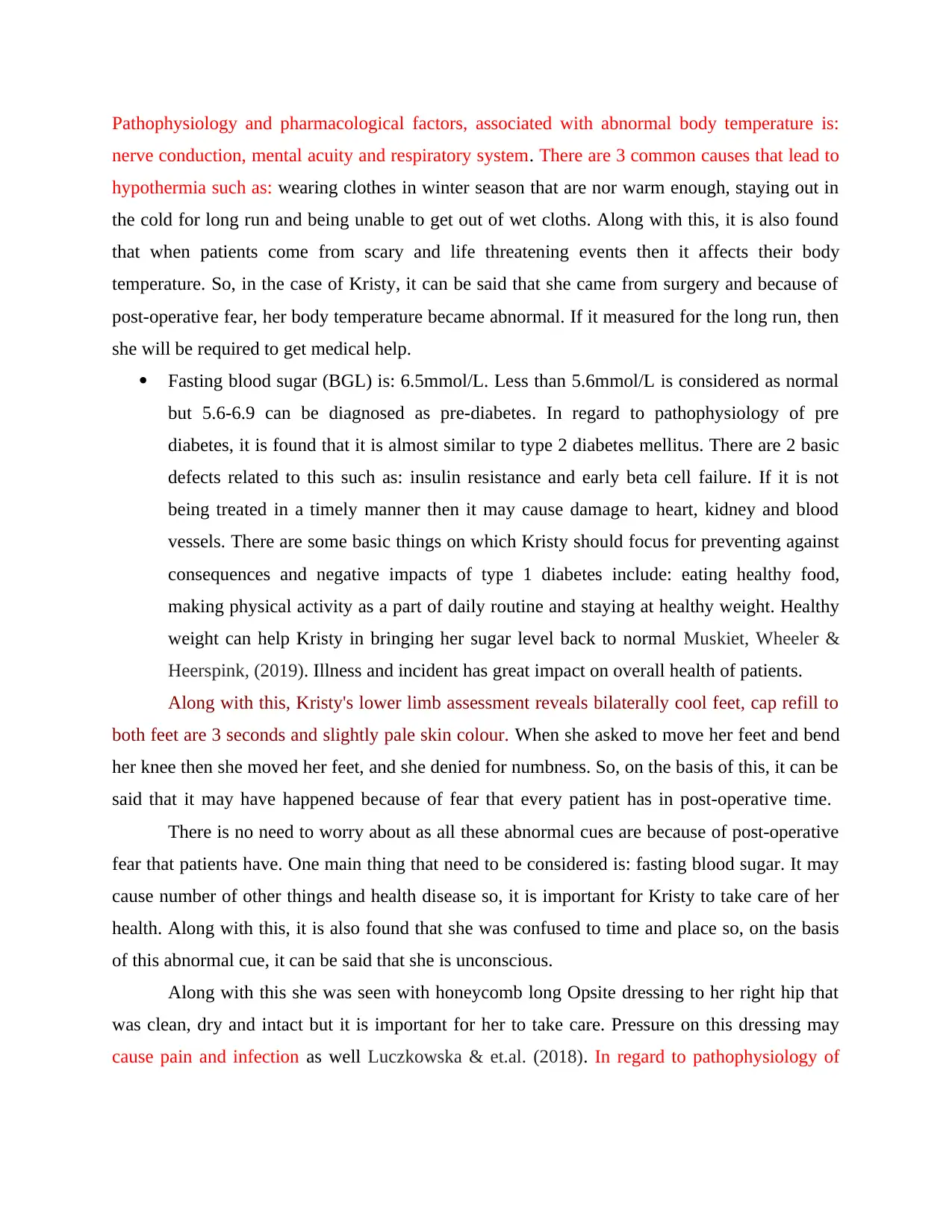
Pathophysiology and pharmacological factors, associated with abnormal body temperature is:
nerve conduction, mental acuity and respiratory system. There are 3 common causes that lead to
hypothermia such as: wearing clothes in winter season that are nor warm enough, staying out in
the cold for long run and being unable to get out of wet cloths. Along with this, it is also found
that when patients come from scary and life threatening events then it affects their body
temperature. So, in the case of Kristy, it can be said that she came from surgery and because of
post-operative fear, her body temperature became abnormal. If it measured for the long run, then
she will be required to get medical help.
Fasting blood sugar (BGL) is: 6.5mmol/L. Less than 5.6mmol/L is considered as normal
but 5.6-6.9 can be diagnosed as pre-diabetes. In regard to pathophysiology of pre
diabetes, it is found that it is almost similar to type 2 diabetes mellitus. There are 2 basic
defects related to this such as: insulin resistance and early beta cell failure. If it is not
being treated in a timely manner then it may cause damage to heart, kidney and blood
vessels. There are some basic things on which Kristy should focus for preventing against
consequences and negative impacts of type 1 diabetes include: eating healthy food,
making physical activity as a part of daily routine and staying at healthy weight. Healthy
weight can help Kristy in bringing her sugar level back to normal Muskiet, Wheeler &
Heerspink, (2019). Illness and incident has great impact on overall health of patients.
Along with this, Kristy's lower limb assessment reveals bilaterally cool feet, cap refill to
both feet are 3 seconds and slightly pale skin colour. When she asked to move her feet and bend
her knee then she moved her feet, and she denied for numbness. So, on the basis of this, it can be
said that it may have happened because of fear that every patient has in post-operative time.
There is no need to worry about as all these abnormal cues are because of post-operative
fear that patients have. One main thing that need to be considered is: fasting blood sugar. It may
cause number of other things and health disease so, it is important for Kristy to take care of her
health. Along with this, it is also found that she was confused to time and place so, on the basis
of this abnormal cue, it can be said that she is unconscious.
Along with this she was seen with honeycomb long Opsite dressing to her right hip that
was clean, dry and intact but it is important for her to take care. Pressure on this dressing may
cause pain and infection as well Luczkowska & et.al. (2018). In regard to pathophysiology of
nerve conduction, mental acuity and respiratory system. There are 3 common causes that lead to
hypothermia such as: wearing clothes in winter season that are nor warm enough, staying out in
the cold for long run and being unable to get out of wet cloths. Along with this, it is also found
that when patients come from scary and life threatening events then it affects their body
temperature. So, in the case of Kristy, it can be said that she came from surgery and because of
post-operative fear, her body temperature became abnormal. If it measured for the long run, then
she will be required to get medical help.
Fasting blood sugar (BGL) is: 6.5mmol/L. Less than 5.6mmol/L is considered as normal
but 5.6-6.9 can be diagnosed as pre-diabetes. In regard to pathophysiology of pre
diabetes, it is found that it is almost similar to type 2 diabetes mellitus. There are 2 basic
defects related to this such as: insulin resistance and early beta cell failure. If it is not
being treated in a timely manner then it may cause damage to heart, kidney and blood
vessels. There are some basic things on which Kristy should focus for preventing against
consequences and negative impacts of type 1 diabetes include: eating healthy food,
making physical activity as a part of daily routine and staying at healthy weight. Healthy
weight can help Kristy in bringing her sugar level back to normal Muskiet, Wheeler &
Heerspink, (2019). Illness and incident has great impact on overall health of patients.
Along with this, Kristy's lower limb assessment reveals bilaterally cool feet, cap refill to
both feet are 3 seconds and slightly pale skin colour. When she asked to move her feet and bend
her knee then she moved her feet, and she denied for numbness. So, on the basis of this, it can be
said that it may have happened because of fear that every patient has in post-operative time.
There is no need to worry about as all these abnormal cues are because of post-operative
fear that patients have. One main thing that need to be considered is: fasting blood sugar. It may
cause number of other things and health disease so, it is important for Kristy to take care of her
health. Along with this, it is also found that she was confused to time and place so, on the basis
of this abnormal cue, it can be said that she is unconscious.
Along with this she was seen with honeycomb long Opsite dressing to her right hip that
was clean, dry and intact but it is important for her to take care. Pressure on this dressing may
cause pain and infection as well Luczkowska & et.al. (2018). In regard to pathophysiology of
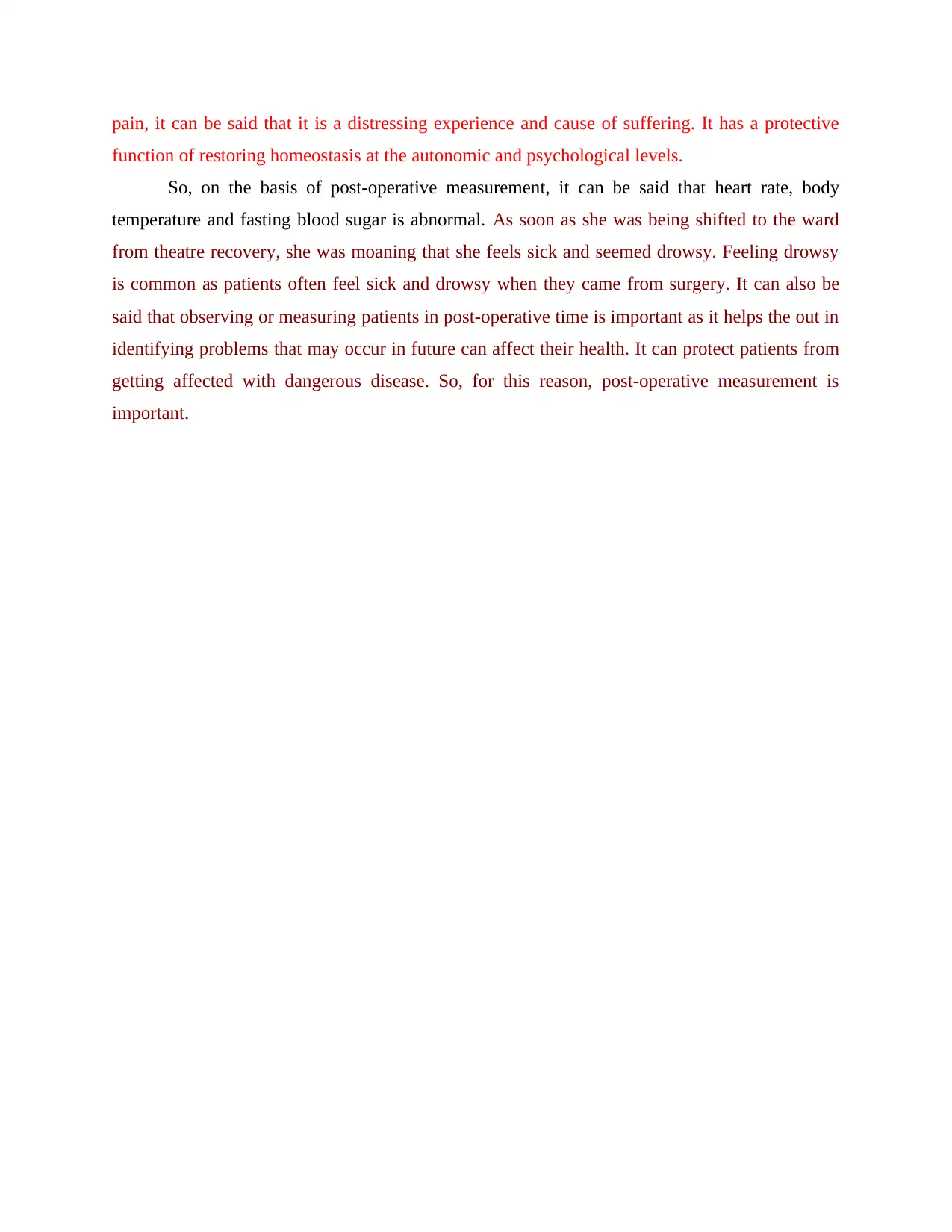
pain, it can be said that it is a distressing experience and cause of suffering. It has a protective
function of restoring homeostasis at the autonomic and psychological levels.
So, on the basis of post-operative measurement, it can be said that heart rate, body
temperature and fasting blood sugar is abnormal. As soon as she was being shifted to the ward
from theatre recovery, she was moaning that she feels sick and seemed drowsy. Feeling drowsy
is common as patients often feel sick and drowsy when they came from surgery. It can also be
said that observing or measuring patients in post-operative time is important as it helps the out in
identifying problems that may occur in future can affect their health. It can protect patients from
getting affected with dangerous disease. So, for this reason, post-operative measurement is
important.
function of restoring homeostasis at the autonomic and psychological levels.
So, on the basis of post-operative measurement, it can be said that heart rate, body
temperature and fasting blood sugar is abnormal. As soon as she was being shifted to the ward
from theatre recovery, she was moaning that she feels sick and seemed drowsy. Feeling drowsy
is common as patients often feel sick and drowsy when they came from surgery. It can also be
said that observing or measuring patients in post-operative time is important as it helps the out in
identifying problems that may occur in future can affect their health. It can protect patients from
getting affected with dangerous disease. So, for this reason, post-operative measurement is
important.

REFERENCES
Books and journals
Al Maqbali, M. R. & et.al. (2019). The nursing profession in Oman: An overview. Nursing
science quarterly, 32(4), 322-325.
Bird, A. (2019). Mentioning the unmentionable: a stoma care nurse's journey to discussing
sexuality comfortably with ostomates. Gastrointestinal Nursing, 17(3), 24-28.
Blomberg, A. C., Bisholt, B., & Lindwall, L. (2018). Responsibility for patient care in
perioperative practice. Nursing open,. 5(3). 414-421.
Gröndahl, W. & et.al. (2019). Perceived quality of nursing care and patient education: a cross-
sectional study of hospitalised surgical patients in Finland. BMJ open. 9(4). e023108.
Keene, A. R. & et.al. (2019). Taking capacity seriously? Ten years of mental capacity disputes
before England's Court of Protection. International journal of law and psychiatry. 62.
56-76.
Liu, W. & et.al. (2020). Analysis of factors associated with disease outcomes in hospitalized
patients with 2019 novel coronavirus disease. Chinese medical journal, 133(09), 1032-
1038.
Luczkowska, K. & et.al. (2018). Pathophysiology of drug-induce peripheral neuropathy in
patients with multiple myeloma. J Physiol Pharmacol. 69(2). 165-172.
Muskiet, M. H., Wheeler, D. C., & Heerspink, H. J. (2019). New pharmacological strategies for
protecting kidney function in type 2 diabetes. The Lancet Diabetes &
Endocrinology. 7(5). 397-412.
Peate, I. (2019). A systematic approach to nursing care. Learning to Care: The Nurse Associate,
109.
Viljoen, S. (2021). A relational theory of data governance. Yale LJ, 131, 573.
1
Books and journals
Al Maqbali, M. R. & et.al. (2019). The nursing profession in Oman: An overview. Nursing
science quarterly, 32(4), 322-325.
Bird, A. (2019). Mentioning the unmentionable: a stoma care nurse's journey to discussing
sexuality comfortably with ostomates. Gastrointestinal Nursing, 17(3), 24-28.
Blomberg, A. C., Bisholt, B., & Lindwall, L. (2018). Responsibility for patient care in
perioperative practice. Nursing open,. 5(3). 414-421.
Gröndahl, W. & et.al. (2019). Perceived quality of nursing care and patient education: a cross-
sectional study of hospitalised surgical patients in Finland. BMJ open. 9(4). e023108.
Keene, A. R. & et.al. (2019). Taking capacity seriously? Ten years of mental capacity disputes
before England's Court of Protection. International journal of law and psychiatry. 62.
56-76.
Liu, W. & et.al. (2020). Analysis of factors associated with disease outcomes in hospitalized
patients with 2019 novel coronavirus disease. Chinese medical journal, 133(09), 1032-
1038.
Luczkowska, K. & et.al. (2018). Pathophysiology of drug-induce peripheral neuropathy in
patients with multiple myeloma. J Physiol Pharmacol. 69(2). 165-172.
Muskiet, M. H., Wheeler, D. C., & Heerspink, H. J. (2019). New pharmacological strategies for
protecting kidney function in type 2 diabetes. The Lancet Diabetes &
Endocrinology. 7(5). 397-412.
Peate, I. (2019). A systematic approach to nursing care. Learning to Care: The Nurse Associate,
109.
Viljoen, S. (2021). A relational theory of data governance. Yale LJ, 131, 573.
1
1 out of 7
Related Documents
Your All-in-One AI-Powered Toolkit for Academic Success.
+13062052269
info@desklib.com
Available 24*7 on WhatsApp / Email
![[object Object]](/_next/static/media/star-bottom.7253800d.svg)
Unlock your academic potential
© 2024 | Zucol Services PVT LTD | All rights reserved.





